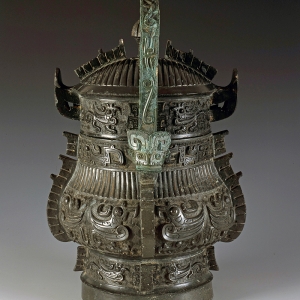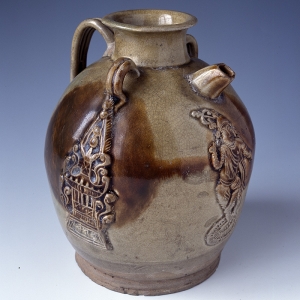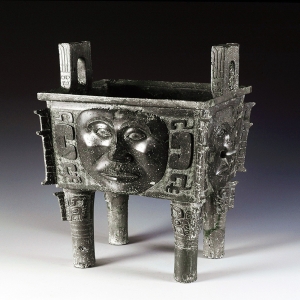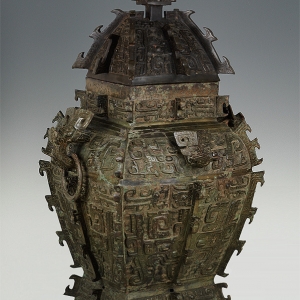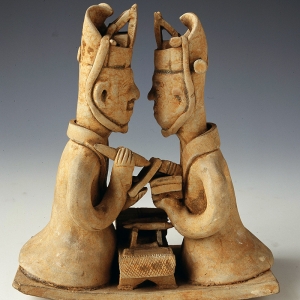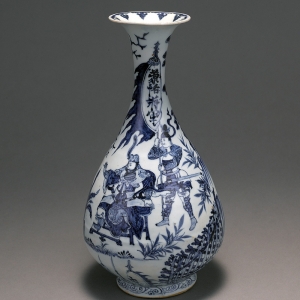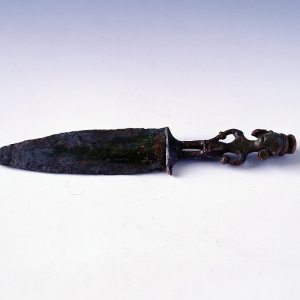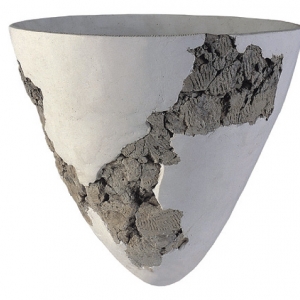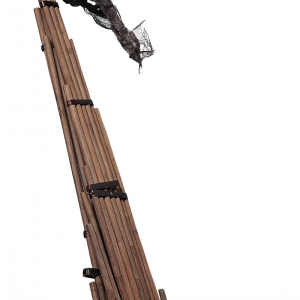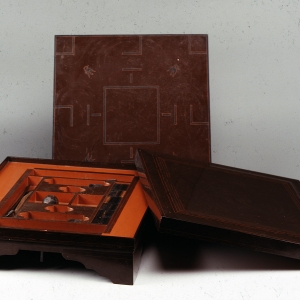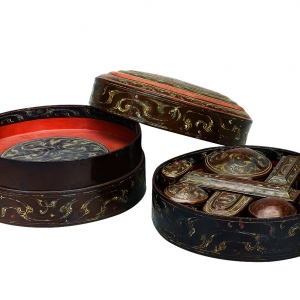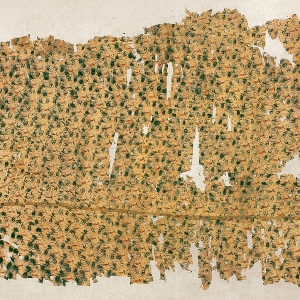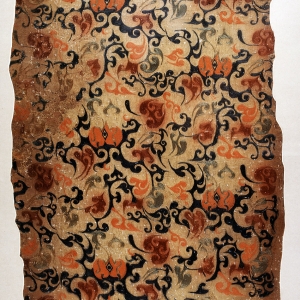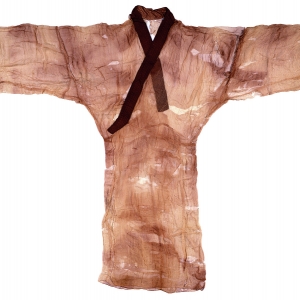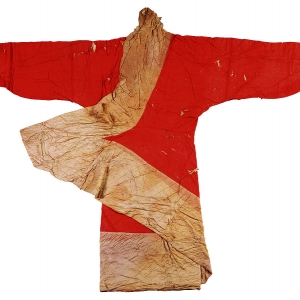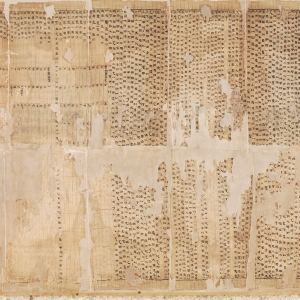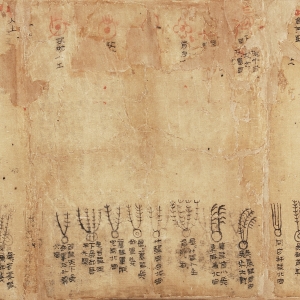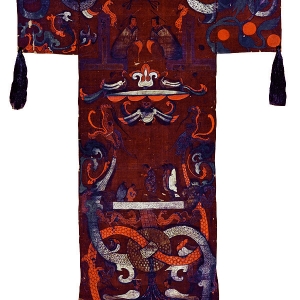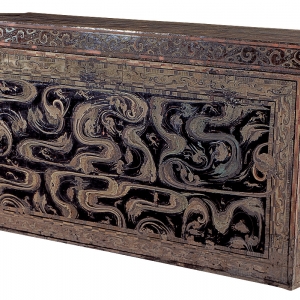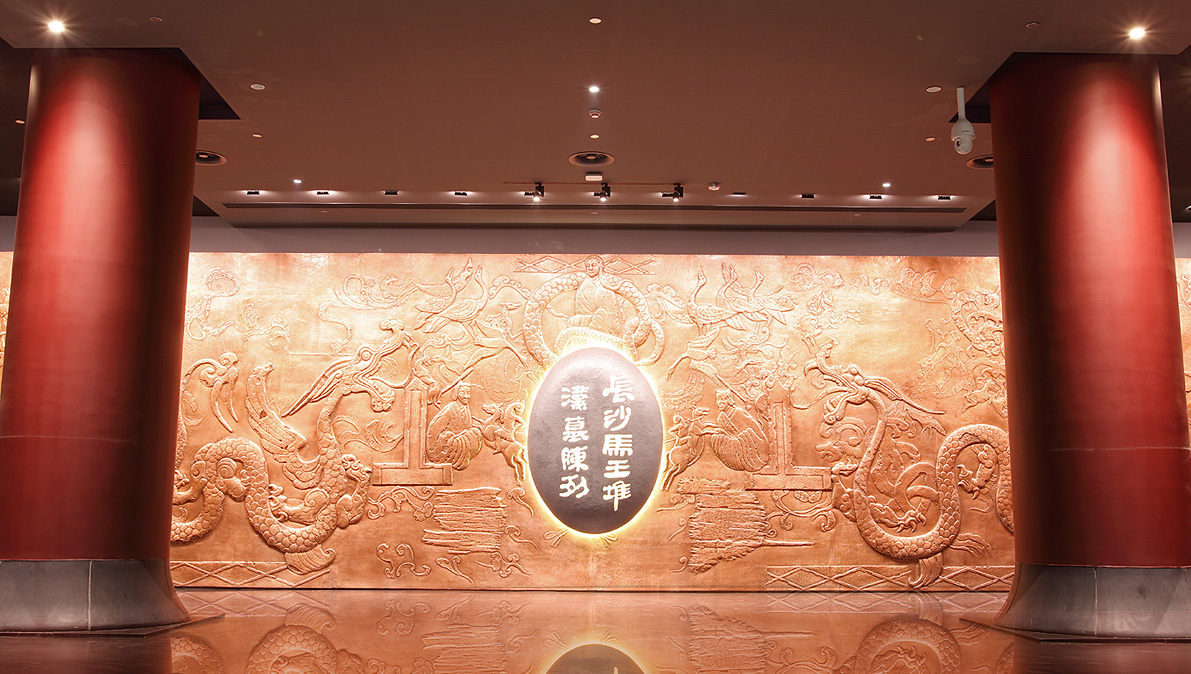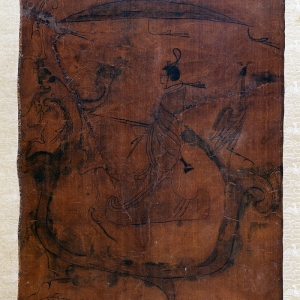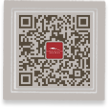馆内

展览介绍
The paintings of Huang Dingchu
Born in Yongfeng town, Shuangfeng county of Hunan province, Huang Dingchu (1943—2016) had multiple titles: member of the China Artists Association and China Printmaking Artists Association, consultant of Chinese Painting Art Committee of Hunan Artists Association, art editor for Xiangjiang Literature (once a monthly publication in Hunan) in 1974, Deputy Secretary General of Hunan Artists Association in 1984 and landscape painter of Hunan Painting and Calligraphy Research Institute in 1990.
Once working on figure printmaking in his early years, Huang later turned to landscape painting and made great achievements. “I didn’t attend art school or receive professional instructions. Deep love of my hometown and beautiful things is my only career motivation. For all hardships encountered these years, my passion never faded in the least.” From the vast Dongting Lake to the charming Xiufeng Mountain, natural scenery of Hunan was a giant magnet to him. Eventually, those diverse landscapes with full expression can be found in his paintings, which were spiritually self-revealing as well as an ode to artistic styles of masters (including ancient ones such as Dong Yuan, Ju Ran, Huang Gongwang Wang Meng and modern ones like Huang Binhong). “Scenery from without, beauty from within; here and there my stroke goes, just the way the mountain runs.” Far beyond a faithful reproduction of outside world, his paintings, with skillful, dynamic brushwork and ingenuous yet connotation-loaded images, are imbued with poetic beauty of traditional Chinese ink painting and profound culture of Hunan area.
According to his will, Huang’s family donated 40 of his works to Hunan Museum. Therefore, we organized this special exhibition to express our deep gratitude for their generosity as well as their contribution to the spread and inheritance of Hunan local culture, hoping the public will gain aesthetic pleasure from the great works.

展品欣赏
- 楚乡清风 138cm*69cm 2011年
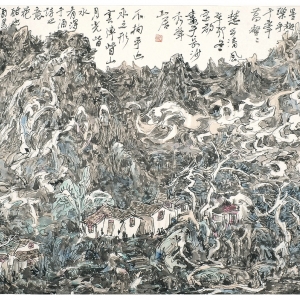
- 垂钓春秋图 138cm*69cm 2013年
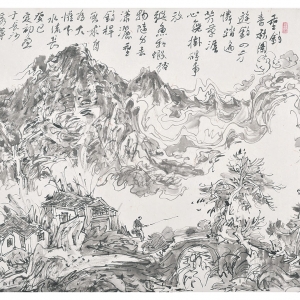
- 登高仰望双峰秀 138cm*69cm 2013年
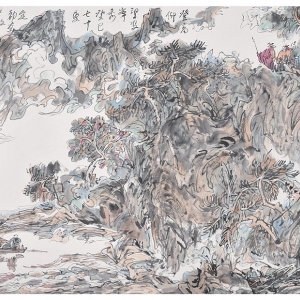
- 洞庭秋月 138cm*69cm 2011年
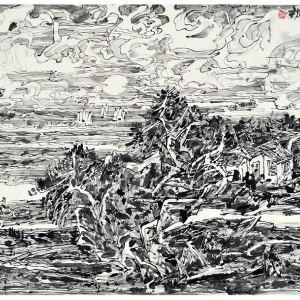
- 洞庭天下水 138cm*69cm 2014年
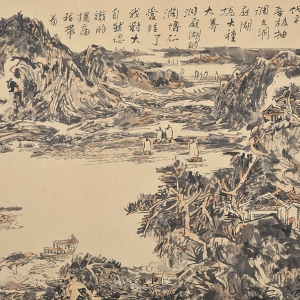
- 新绿 180cm*97cm 1994年
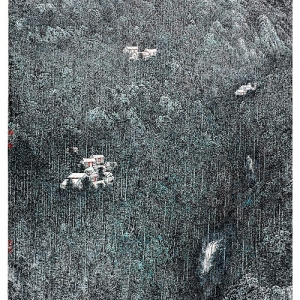
- 太行山随意 70*46 2009年
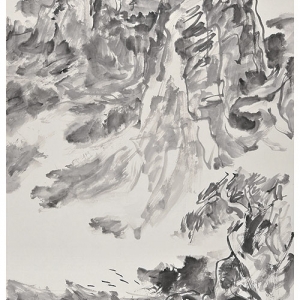
- 赶集 48cm*45cm 2010年
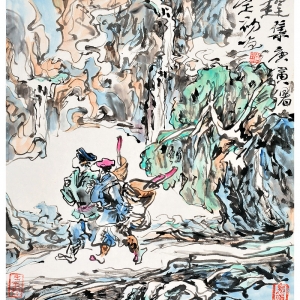
- 善哉 45cm*41cm 2009年
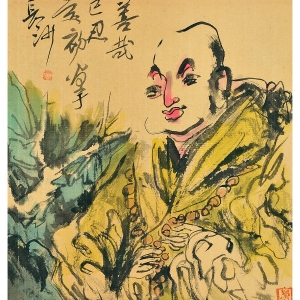
- 云起楚山 248cm*129cm 2002年
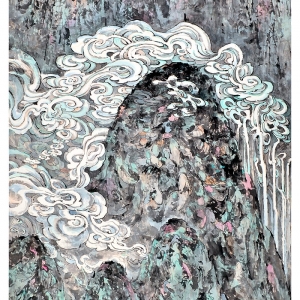
- 秋醉 180cm*97cm 1994年
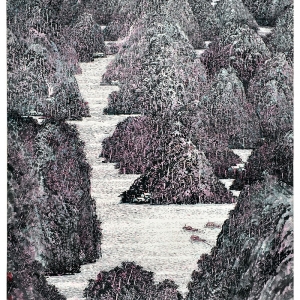
- 笔墨脱法韵自来查看更多
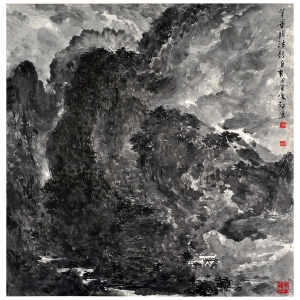
艺术家介绍

Born in Yongfeng town, Shuangfeng county of Hunan province, Huang Dingchu (1943—2016) had multiple titles: member of the China Artists Association and Printmaking Artists Association, consultant of Chinese Painting Art Committee of Hunan Artists Association, art editor for Hunan Literature in 1979, Deputy Secretary General of Hunan Artists Association in 1984 and landscape painter in Hunan Painting and Calligraphy Research Institute in 1990. His landscape painting works exhibitions were held in Changsha in 1997, 2006, and 2012. In 2012, Chinese Contemporary Artists—Huang Dingchu, a collection of his painting works was published by People's Fine Arts Publishing House.

展览介绍
兴来笔下生烟霞——黄定初绘画作品暨捐赠作品展
黄定初(1943——2016),湖南省双峰县永丰镇人。中国美术家协会会员,中国版画家协会会员,湖南美协中国画艺委会顾问,1974年任《湘江文学》美术编辑,1984年任湖南美术家协会副秘书长,1990年调至湖南书画研究院为专职山水画家。
黄定初先生早年曾从事人物版画创作,后专攻山水画并取得很高成就。“我没有上过艺术院校,也没有师门,凭着对故乡的深情、对美的热爱,干起了专业。年复一年,苦乐参半,甘心爱之”。从浩浩荡荡的洞庭湖到俊俏坚韧的秀峰山,湘楚大地上几乎都留下了黄定初先生的游览及写生足迹;外师造化,中得心源,故乡的美景与古朴的乡情激发了黄定初先生的创作灵感,饱含湘楚山水灵气的笔墨语言特征也由此生发出来。“画可营造,境由心生,是吾写山写水之本;笔墨随山而转,是吾作画之法”,在表达自我的同时,董源、巨然、黄公望、王蒙等古贤及黄宾虹等近现代大师的笔意也一并融入其画作。黄定初先生的山水作品,已不止于忠实再现客观物象,灵动的笔墨与图案化的山水云彩浑然一体,充分表现了传统绘画的笔墨意趣,并将湖湘文脉的深厚底蕴注入其中。
黄定初先生家属根据先生生前意愿,向湖南省博物馆捐赠40件黄定初先生书画作品。此举丰富了湖南省博物馆关于湘籍书画名家的收藏,对于湖南的书画传承亦具有深远的意义。因此,我馆特举办“黄定初绘画作品暨捐赠作品展”,以感谢黄定初先生家属的义举,同时也回馈社会,希望公众能借此领略先生绘画的魅力,感受山水画的趣味。
“半隐半醉瘦影斜,寒灯对月静煮茶。无限天书倚炉看,兴来笔下生烟霞”。让我们伴随着先生一生沉迷读书作画的兴致走进他的绘画世界。

展品欣赏
- 楚乡清风 138cm*69cm 2011年

- 垂钓春秋图 138cm*69cm 2013年

- 登高仰望双峰秀 138cm*69cm 2013年

- 洞庭秋月 138cm*69cm 2011年

- 洞庭天下水 138cm*69cm 2014年

- 新绿 180cm*97cm 1994年

- 太行山随意 70*46 2009年

- 赶集 48cm*45cm 2010年

- 善哉 45cm*41cm 2009年

- 云起楚山 248cm*129cm 2002年

- 秋醉 180cm*97cm 1994年

- 笔墨脱法韵自来查看更多

艺术家介绍

黄定初(1943—2016),湖南省双峰县永丰镇人。中国美术家协会会员,中国版画家协会会员,湖南美协中国画艺委会顾问。1979年任《湖南文学》美术编辑,1984年任湖南美术家协会副秘书长,1990年调湖南书画研究院为专职山水画家。1997年、2006年、2012年先后在长沙举办山水画作品展。2012年由人民美术出版社出版个人画集 “大红袍”系列之《中国当代名家-黄定初》。
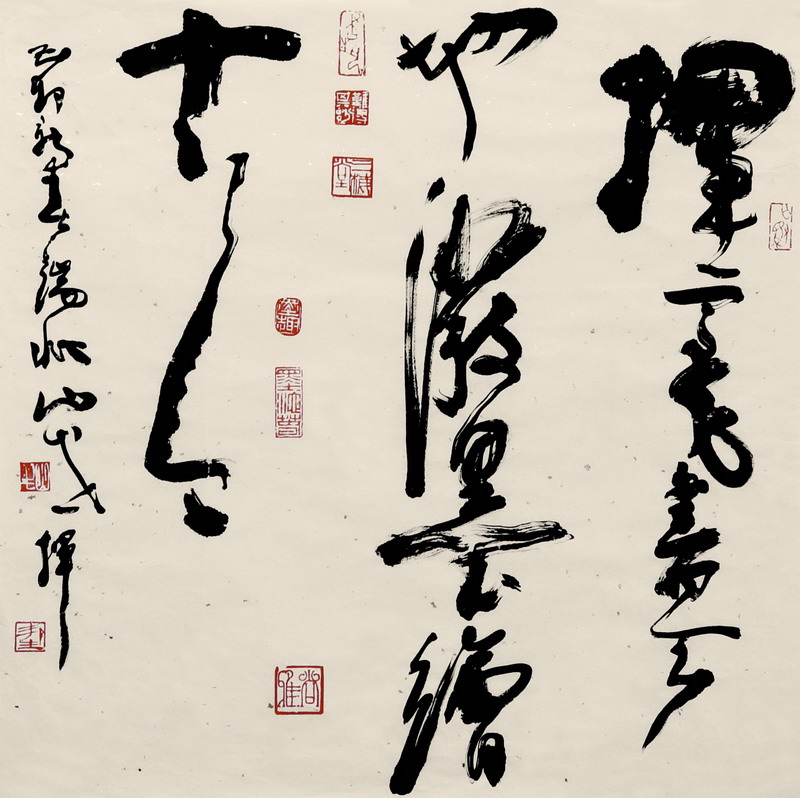
展览介绍
Passion Cast in Chinese Ink and Brush- an Exhibition of Paintings by Wu Bangsheng
Passion Cast in Chinese Ink and Brush- an Exhibition of Paintings by Wu BangshengBorn in Huaiji County, Guangdong Province in 1935, Wu Bangsheng was a military artist in Guangdong Province since 1950s, during which he created many works that attracted the attentions of the whole art community. And many of his works were collected by Chinese Art Museum and other influential art institutions. Obsessed with painting deer and dances by people, he blazed a trail by himself and explored an art realm of his own. Therefore, many of his works were selected for national art exhibition and were awarded with prizes time and again. In the 1960s when he took office in Hunan Federation of Literary and Art Circles, he played a greatly significant role in promoting the development of art and calligraphy in Hunan Province. In the 1990s, he was then transferred to the City of Zhaoqing in Guangdong Province, and now he serves as the vice president of Zhaoqing Federation of Literary and Art Circles, president of Zhaoqing Artist Association and dean of Zhaoqing Art Academy.
The exhibition presents more than one hundred pieces of works which feature masterpieces of Wu Bangsheng from different periods varying from the earliest in 1973 to the recent one. Wu excels in Chinese figure painting, but also shows interest in drawing deer, dance painting and Chinese calligraphy. His paintings were produced smoothly and full of charm. A few strokes unfold a vivacious deer on a piece of paper and several lines with unique rhythm present a gracefully slender dancer dressed in robes with long and colorful sleeves. The artistic appeal found in his works is deeply rooted in his unremitting exploration for Chinese painting art and the artistic conception, just as the renowned literary theorist Wang Zhaowen once commented on his works: “Bangsheng, in his paintings, lays emphasis on delivering the emotion implied in poems, creating the artistic conception of paintings and presenting the charm contained in Chinese ink.” A Chinese classic teaches that “if calligraphy is finished in the same way as the painting is done, the calligraphy works will also be full of charm.” Likewise, Wu’s calligraphy works, similar to his paintings, strive for the artistic conception, charm and rhythm.
This year, Wu Bangsheng decided to donate 80 pieces of works from his life-long creation to the Hunan Provincial Museum for free. Such a magnanimous act moved all. And this exhibition held by Hunan Provincial Museum aims to not only demonstrate Wu’s achievements in art, but also convey appreciation for his generous donation.

展品欣赏
- Golden Autumn on Miaoling Mountains
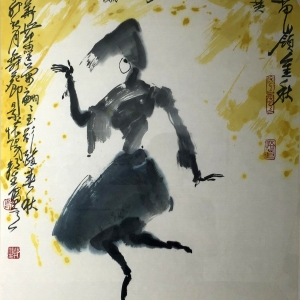
- Grazing Season
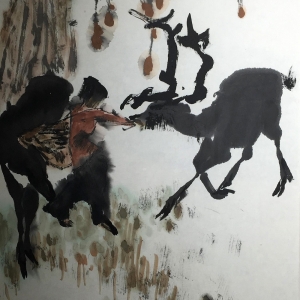
- Mountain Rain
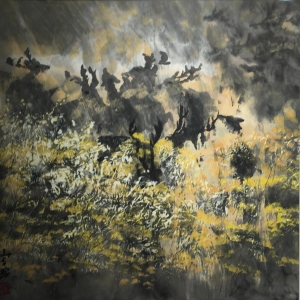
- Charm of Lion
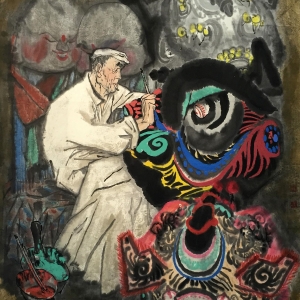
- Inscription by Su Shi, a great poet of Song Dynasty, on Duanxi Ink Stone
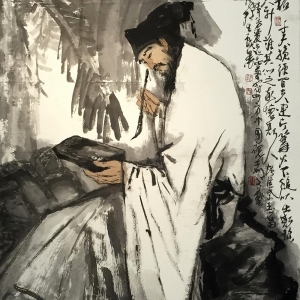
- Inscription by Su Shi, a great poet of Song Dynasty, on Duanxi Ink Stone
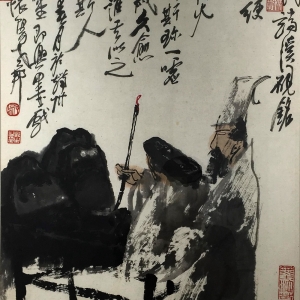
- A Touching Scene of the Cow Gently Licking the Calf
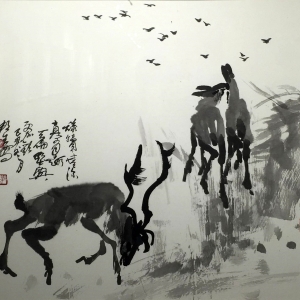
- Frontier Area after the Rain
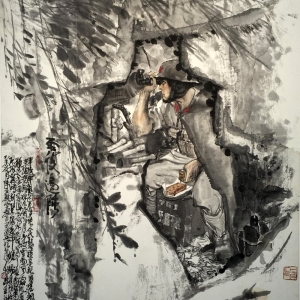
- Festive Lantern Dance on the Lantern Festival
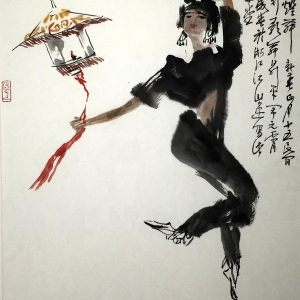
- Indulgence in Spring
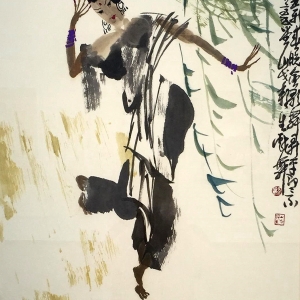
- A Party Branch Built in the Company
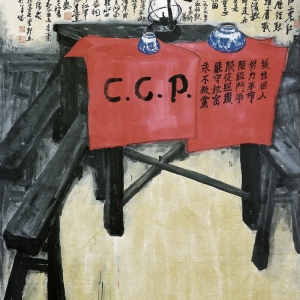
- Eternity Carved into the Stone Tip查看更多
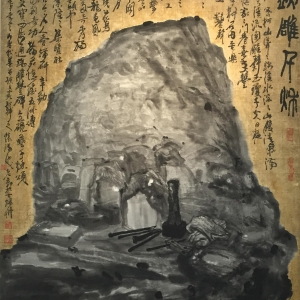
艺术家介绍
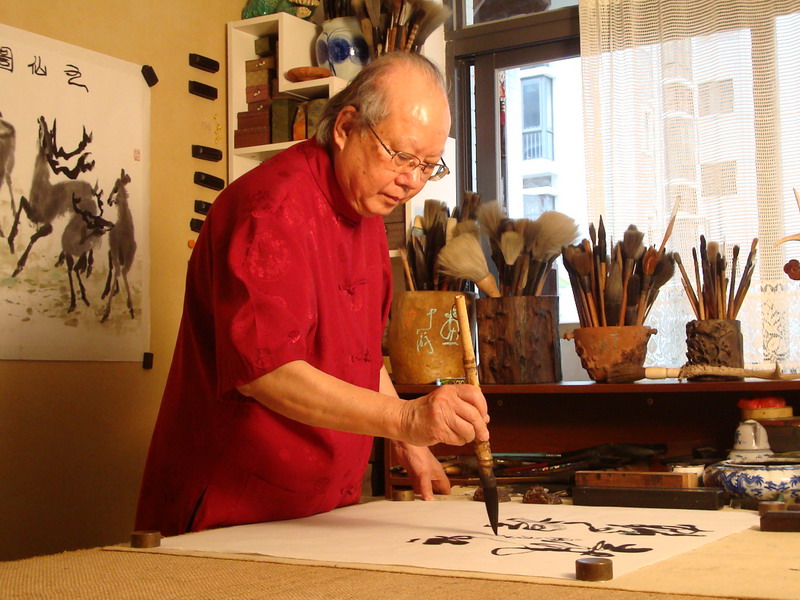
Born in Huaiji County, Guangdong Province in 1935, Wu Bangsheng is a member of China Artists Association, director of Chinese Calligraphers Association, an editorial board member of the Chinese Calligraphy Art Gallery and a national first-class artist. Since 1975, he successively served as the cultural instructor, head of the stage art team and art creation full-time cadre in Guangzhou Military. In 1968, he assumed office as the head of Creative Department of the Hunan Artists Association, being one of the founders of the Hunan Art Academy, Hunan Calligraphers Association and Hunan Jiuge Painting and Calligraphy Academy as well as the first full-time vice president and associate dean. In 1993, he was transferred to Zhaoqing City to serve as the vice president of Zhaoqing Federation of Literary and Art Circles, director of Guangdong Artists Association and Guangdong Calligraphers Association as well as the honorary president and dean of Zhaoqing Artists Association, Zhaoqing Calligraphers Association and Zhaoqing Art Academy.
As one of the famous contemporary Chinese painters and calligraphers, Wu Bang sheng, besides excelling in Chinese figure painting, is well versed in deer and dance painting as well as calligraphy, creating abundant works. His traditional Chinese paintings such as After Class, When Leaving the Village, A Disciplined Role Model, It Is Beneficial to Compare with, Learn from, Keep up with and Help Each Other are collected by Chinese Art Museum. In addition, his works like A Party Branch Was Built in the Company, During a Night Journey across a Village, No Hoof Beat Was ever Heard, Charm of Lion, In the Thunderstorm, Self-written Poems and Calligraphy, comic books including On Sha Tian Road, The Handcuffed Passenger, Three Gorges Goddess and many other masterpieces have been selected to be on display in National Comprehensive Art Exhibitions and National Comprehensive Calligraphy and Seal Exhibitions many times as well as being included and published in The East Is Red, Collected Works of Chinese Art, A Grand View of International Calligraphy Masterpieces and other national large-scale painting albums, and some of his works have been chosen by scenic spots around the country to serve as couplets engraved on the board, inscriptions and murals. In 2012, Wu was selected as one of the 30 Most Academically Valuable Flower-and-bird Painters in contemporary China. In 2013, he was among the first batch of artists in the literary and art circles of Zhaoqing, awarded with the title of Artists Excellent Both in Performing Skills and Moral Integrity by the Propaganda Department of Zhaoqing Municipal Party Committee and Zhaoqing Federation of Literary and Art Circles.
Wu is in endless pursuit of the beauty of artistic conception, composition of a painting and charm of Chinese ink. As well as focusing on Chinese figure painting, he also demonstrates talent in calligraphy and bears fruitful outcomes. Especially in his exploration for deer, dance and ancient poetry paintings, he draws in a sketchy, lively and innovative way, making it all more poetic and full of artistic appeal. When drawing deer, he uses thick ink for horns while light ink for the body, and a few strokes unveils a lively deer on the paper. For dance painting, a smooth stroke produces the figure and another shapes the dress. It only takes a piece of orchestral music for him to unfold a graceful and vivid dancer in robes and flying sleeves. For opera scene, under his brush, different shades of dripping ink are perfectly integrated. When doing ancient poetry painting, he recedes from the mundane life, pretends to be clumsy and conceals wisdom within, of which the artistic conception can be demonstrated by “exotic charm from afar”. His calligraphy is also unique in style, especially his cursive script, which inherits the vigorous and unrestrained manner in Ming Dynasty. He lays emphasis on composition, brushwork and use of ink by applying thick or light shades of ink in an innovative way. His natural and unrestricted strokes give people a feeling of lightness yet with a wisp of thickness, light yet powerful. When he is writing a calligraphy work, he integrates the artistic conception of the painting, adding a peculiar appeal to it. Comparing his calligraphy to his painting, one will immediately finds out that his painting and calligraphy are fused with each other. Obviously, Wu has his own deep understanding about this, which epitomizes why he combines calligraphy with painting for ingenuity and vitality, finally creating an artistic world for himself.

展览介绍
翰墨铸情——邬邦生书画作品展
邬邦生先生1935年出生于广东省怀集县,上个世纪五十年代在广东省即为军旅画家,创作了很多在全国美术界有影响的作品,其中不少作品被中国美术馆等重要艺术机构收藏。又醉心于画鹿、画舞,探索出属于自己的一片天地,其作品屡次参加全国美展并获奖。六十年代到湖南文联工作,更是极大地推动湖南省美术、书法事业的发展。九十年代调入广东省肇庆市,现为肇庆市文联副主席、市美协主席、肇庆画院院长。
本次展览汇集了邬邦生先生的各个时期具有代表性的作品,共一百余件,最早的作品创作于1973年,同时也展出了近期的新作。先生以中国人物画创作为主,亦喜画鹿画舞兼工书法。绘画笔墨酣畅,极具神韵:浓淡几笔,一只鹿儿便呦呦欢鸣于纸上;极富韵律的几根线条,又浮现彩袖飘舞、婀娜多姿的舞者,这种艺术感染力来源于先生对于笔墨、意境的不懈探索。故著名文艺理论家王朝闻先生评:“邦生作画重诗之情,画之境,墨之韵的追求”。古人云:“以画参入书,而书无不神”,先生的书法也参入画的意境,其书同样追求意境和韵律。
今年邬邦生先生与我馆达成捐赠意愿,将自己毕生创作中的80幅作品无偿捐赠于湖南省博物馆,先生之义举,无不令人动容。我馆举办此次展览,一是为展示先生的艺术成就,二是为感念先生慷慨捐赠的行为。愿各位观众能够欣赏、品味这些作品,从中感悟艺术的真、善、美。

展品欣赏
- 苗岭金秋

- 秋牧

- 山雨

- 狮韵

- 苏轼端溪砚铭

- 苏轼端溪砚铭

- 舔犊情深真有趣

- 雨后边陲

- 元宵花灯舞

- 醉春舞

- 支部建在连上

- 端雕千秋查看更多

艺术家介绍

邬邦生先生1935年生于广东怀集县,中国美协会员、中国书协理事、《中国书法艺术库》编委、国家一级美术师。1957年以来先后任广州部队文化教员、舞美组长、美术创作专干。1968年以来任湖南省美协创作部部长,为湖南省画院、省书协、省九歌书画院创始人之一,首任专职副主席、副院长。1993年调入肇庆市文联任副主席、广东省美协、书协理事、肇庆市美协、书协、市画院名誉主席、院长。
作为中国当代著名书画家之一,主要以创作中国人物画为主,擅画鹿画舞,兼攻书法,创作甚丰。他的国画《课余》、《离村时》、《守纪模范》、《比学赶帮好》被中国美术馆收藏;《支部建在连上》、《夜过山村无蹄声》、《狮韵》、《雷雨声中》、《自撰诗联书法》、连环画《沙田路上》、《戴手铐的旅客》、《三峡神女》等多件佳作入选多届全国综合美展、全国书法篆刻大展,并被刊入国家出版的《东方红》、《中国美术全集》、《国际书法名作大观》等大型画册;部分书画被全国名胜景区刻制匾联、碑刻、壁画等。2012年邬邦生被评选为当代全国30位最具学术价值的花鸟画家,2013年被肇庆市委宣传部、市文联授予肇庆市文艺界首批“德艺双馨”艺术家称号。
邬邦生先生在艺术创作上追求意境、构图、墨韵之美,主攻人物画兼工书法,创作甚丰。特别在画鹿、画舞、画古诗意探索中,画得简约、明快、富有新意,更有诗书意境。邬邦生画鹿,浓墨写犄角,淡墨完体肤,笔墨纵横,一只鹿儿便呦呦欢鸣于纸上;画舞,一笔成身,一划成裙,只消一曲管弦,满纸俨然彩袖舞飘;画戏,彩墨淋漓,浑然一气;画古诗意,则褪尽俗尘,拙中藏巧,愚中见智,其形神境界俱可用“异香幽远”概言之。邬邦生的书法,亦有自己的风格,特别是他的行草书,具有明代书艺之雄健潇洒的风采。他注重章法、笔法、墨法,别开生面地参入了浓淡墨,道法自然的挥洒,读之给人觉得淡而厚、淡而美、淡而有力量。比如他分明在作书,却揉进了画的意境,给作品平添异样的韵味和情趣。比照他的书法,再读他的画作,旋即发现他的画也参入了书法。显然,邬先生对此自有其深层的思考,故而取“以书骨入画求妙”,“以画韵入书得神”,构成了他的艺术世界。
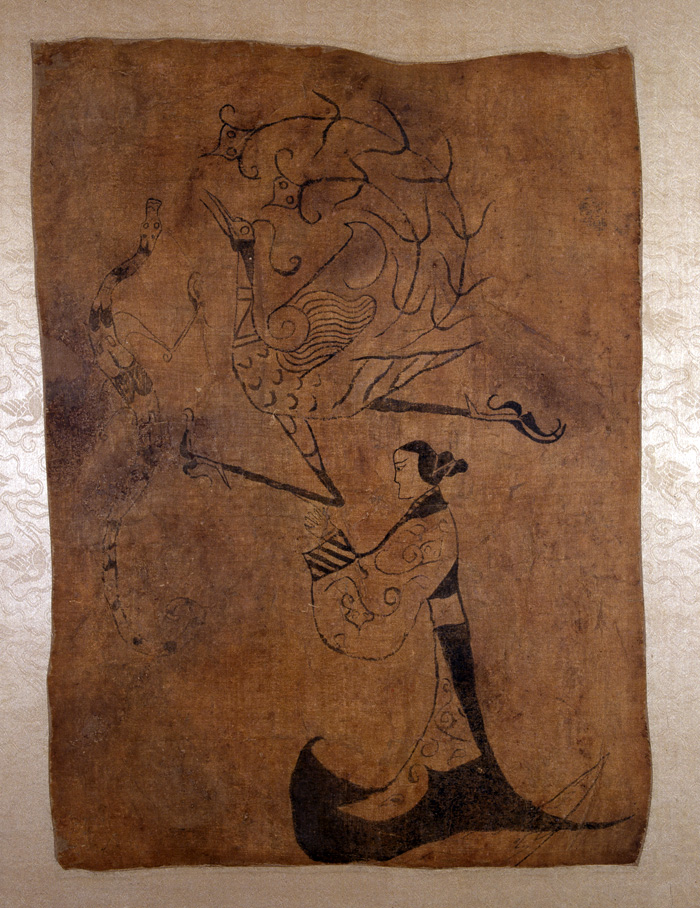
展览介绍
호남인-삼상역사문화 진열
중남의 중심 지역에 위치하여 있는 호남성은 북쪽에 동정호(洞庭湖)가 있고 세면은 높은 산과 우뚝 선 봉우리에 둘러싸이며 기후가 따뜻하고 토양이 비옥하여 “부용국”이라고도 부른다. 50만년 전부터 선조들은 이곳에서 생활하기 시작하였으며 넓고 너그러운 마음으로 이민들을 맞이하여 오늘의 “호남인”으로 되었다.
처음의 야생벼와 인공벼의 재배부터 오늘의 교잡벼까지 호남사람들은 예로부터 벼농사를 중요시하였다. 호남사람들은 대대로 그들의 부지런함과 지혜로 곡창을 풍족하게 하고 서로 농사를 도우며 안정하고 쾌적한 전원생활을 하면서 호남을 “천하의 곡식창고”인 어미지향(鱼米之乡)으로 만들었다. 호남사람들은 밥쌀과 생선요리에서 생활을 맛보며 역사의 흐름에 따라 기물에 기재되는 도를 추구하면서 신에게 제사를 지내는 상주(商周)의 예법과 음악 그리고 청동기부터 생활품질을 보여주는 초한(楚汉)의 칠목기와 대중들의 사랑을 받고 있는 장사 도자기 그리고 명청(明清)종족 마을까지 모두 호남의 풍속과 신앙 그리고 생활방식을 반영하는 것이다.
몇 천년 동안 나라를 사랑하고 국민의 생활을 걱정하는 생각과 중원문화의 세련과 서원교육의 계승 그리고 근대 생각의 흔들림을 거치면서 많은 지혜가 있는 현사들을 육성하엿다. 이런 개성적이고 천하가 우선인 호남 사람들은 그들의 충성심과 책임성 그리고 가정과 나라를 지키려는 애국심으로 중화민족의 도약과 위대한 업적을 이루었다.

展厅内景
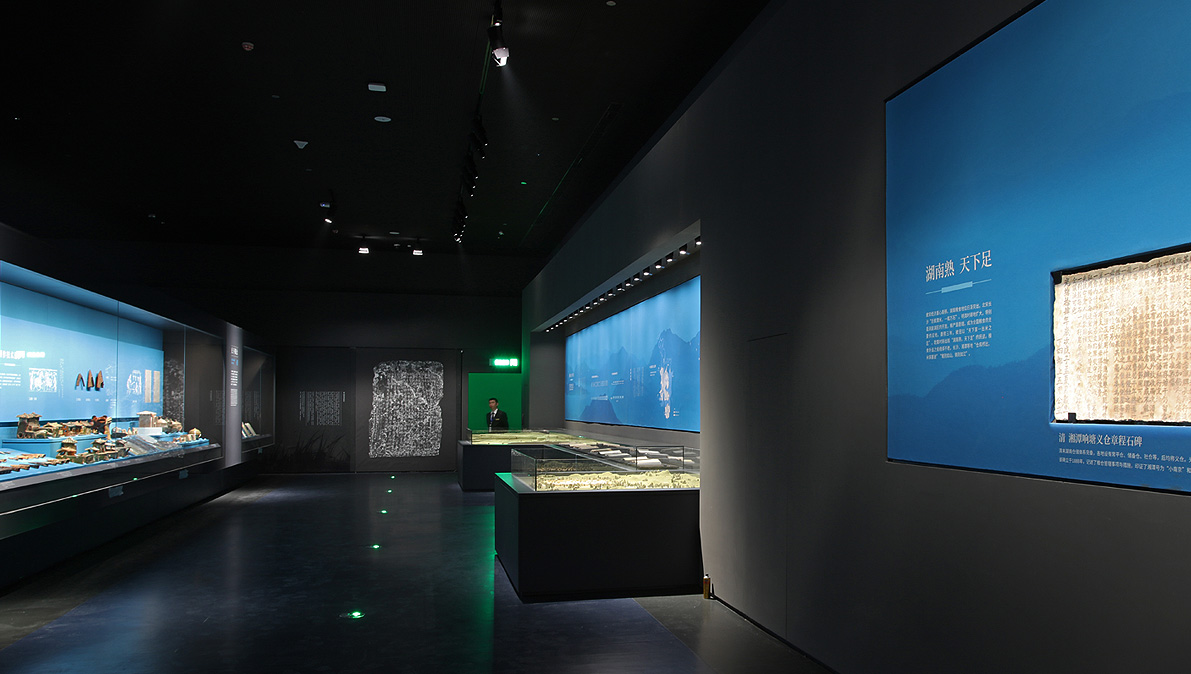
参观指南
개방 시간
매주 화요일~일요일 9:00—17:00(매일16:00부터 입관금지)
매주 월요일 폐관(공휴일은 순연), 설날 1일 폐관.
관람 방법
2대 신분증으로 안전검사를 통과한 후 티켓이 없어도 기본 전시를 관람할 수 있다. 기타 법률적 유효한 신분 증명서는 반드시 매표구에서 티켓을 수령한 후 안전검사를 마치고 입관할 수 있다.
무료개방대상
사회 전체 대중들에게 무료 개방, 12세 이하의 어린이는 반드시 보호자와 함께 관람을 진행하거나 단체 조직으로 관람권을 수령하여 관람을 진행하여야 한다.
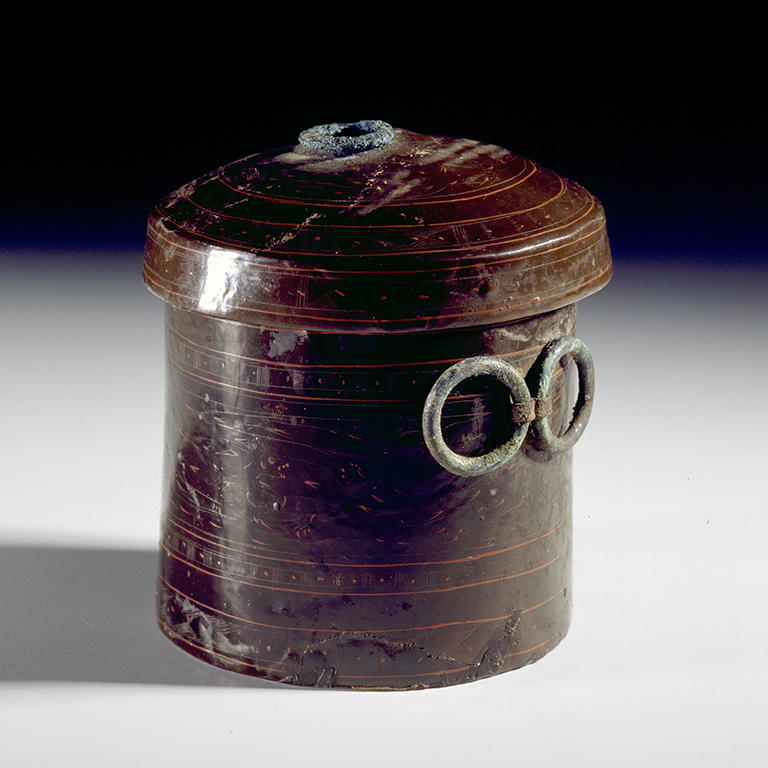
展览介绍
장사 마왕퇴한묘 진열
1972년-1974년에 발굴된 장사 마왕퇴한묘는 20세기의 중대한 고고학 발견 중의 하나이다. 잘 보존된 고분과 풍부한 부장품은 한대(漢代)의 생활방식과 상례와 장례의 관념을 완정하게 보여주었다. 700여건의 높은 수준의 공예칠기는 한대(漢代) 페인트 업계의 발전을 반영하였고 500여건의 정교하고 아름다운 방직물은 서양의 문헌 중에 기재된 “사국”(Seres)의 증명이다. 또한 50여편의 “백과전서”식의 간백문헌은 선조들의 학식과 지혜를 계승하였고 괴이한 채색관 백화에는 하늘을 날아오르고 영원한 생명을 원하는 한대(漢代) 사람들의 갈망이 담겨졌다. 마치 꿈 속의 천년이 된 얼굴처럼 인류 방부기술의 기적을 만들었다. 마왕퇴한묘는 사람들이 2100년 전의 사회 풍모를 알 수 있는 창구로 한대(漢代) 초기 역사의 지표이기도 한다. 이는 경제, 천문, 지리, 역사, 철학, 예술, 의학 등 분야에서의 중국 한대(漢代)의 휘황찬란한 성과를 보여주었으며 중국 고대 문명 역사의 목격자이고 세계 문명의 보물고이기도 한다.
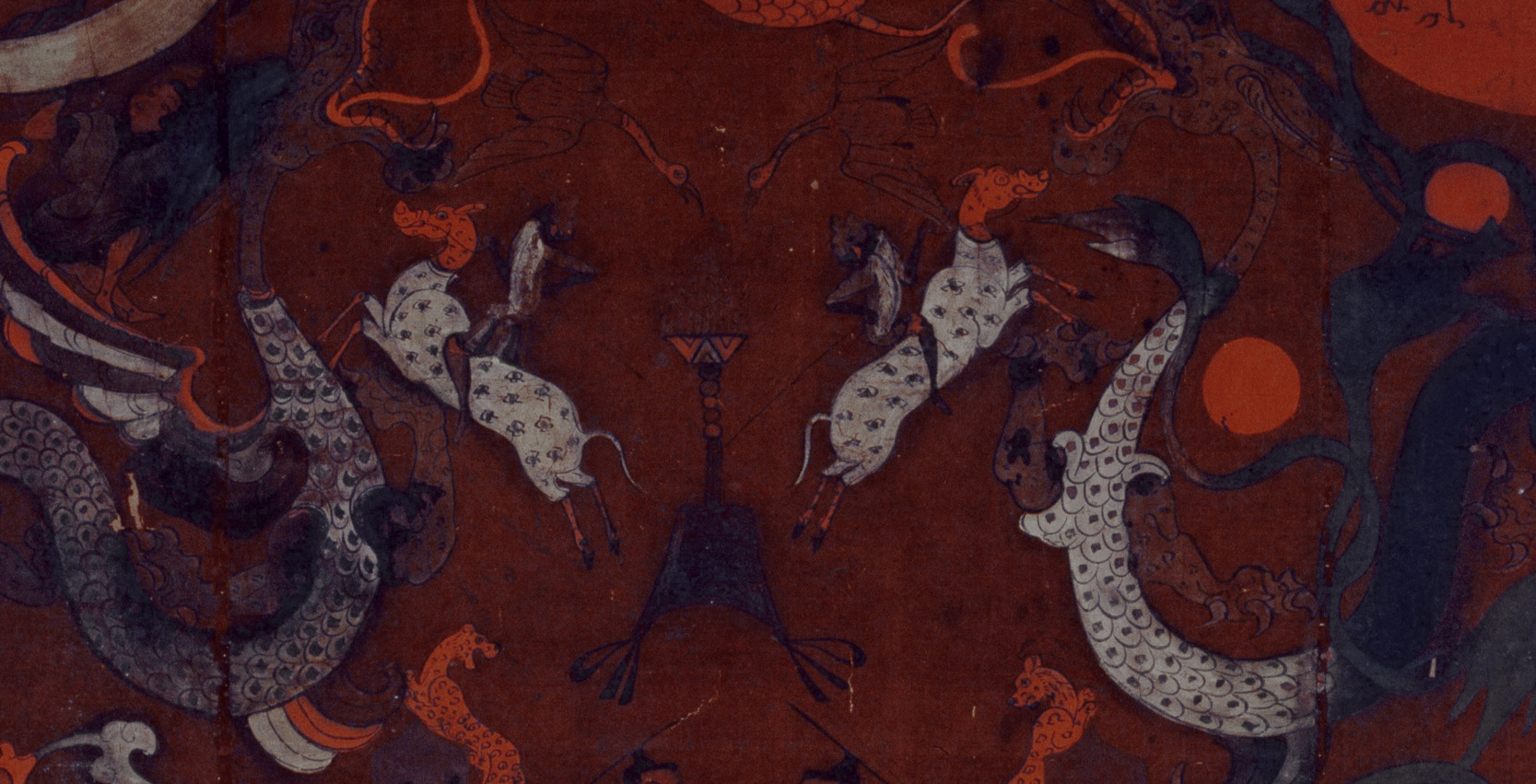
展品欣赏
参观指南
개방 시간
매주 화요일~일요일 9:00—17:00(매일16:00부터 입관금지)
매주 월요일 폐관(공휴일은 순연), 설날 1일 폐관.
관람 방법
2대 신분증으로 안전검사를 통과한 후 티켓이 없어도 기본 전시를 관람할 수 있다. 기타 법률적 유효한 신분 증명서는 반드시 매표구에서 티켓을 수령한 후 안전검사를 마치고 입장할 수 있다.
무료개방대상
사회 전체 대중들에게 무료 개방, 12세 이하의 어린이는 반드시 보호자와 함께 관람을 진행하거나 단체 조직으로 관람권을 수령하여 관람을 진행하여야 한다.

展览介绍
「湖南人――三湘歴史文化陳列」
湖南省は中南の内陸に位置し、北の方に洞庭湖があり、三つの面は山に囲まれている。自然に恵まれ、気候も温和で、土壌も肥沃で、産物も豊富で、唐時代から「芙蓉国」と呼ばれてきた。50万年前から、人類はここに生息している。包容開放の姿で、歴代の移民を融合し、今日の「湖南人」を形成した。
最初の野生稲の馴化と人工稲の栽培から、今の交雑水稲まで、湖南省は古くから稲作農業で知られている。歴代の湖南人は勤勉と知恵を以って、倉の充実を追求し、作業も協力し合い、快適でのんびりした田園生活を経営し、湖南省も「天下穀倉」と呼ばれる魚と米の里となっている。食事はご飯と魚、辛いものが好き、湖南人は生活を味わって、歴史の脈拍を追求しています。特に器物の作成が上手である。商週時代に神霊を祭る靑銅楽器や生活の質を現す楚漢時代の漆の家具や深く大衆に好まれる唐時代の長沙陶磁器や明清時代に耕読伝家を信奉する宗族の村など、全部湖南省の民俗、信仰と生活様式を反映している。
数千年に渡って、愛国と忧民の思想に影響され、中原文化に洗练され、書院教育の伝承と近代思潮の激動で、代々の誌士たちを育てた。まさにこれらの粘り強い、国家のために人の先たる湖南人が、勇敢と信仰を持って、死んで殘念なし、中華民族の飛躍のために自分の力を尽くしている。

展厅内景

参观指南
開放時間
毎週火曜日から日曜日、9:00 ~17:00(毎日16:00入館停止);毎週の月曜日は休館日(法定の祝日の場合は順延)、旧暦大晦日は一日休館。
見学の方式
観客は第二代身分証明書を持ち、安全検査を受けた後、基本的な陳列は無料見学できます。他の有効な身分証明書は先にチケット窓口で切符を受け取り、切符と身分証明書を持って安全検査を受けてから入館できます。
無料開放対象
社会全体で、また12歳以下の児童は親の同行または学校先生の見守りで見学できます。

展览介绍
長沙馬王堆漢墓陳列
972年から1974年までに発掘された長沙馬王堆漢墓は、20世紀世界の最も重大な考古学発見の一つである。墓の構造はよく保存できている上に、副葬品も豊富であり、漢時代の生き方、葬儀の観念をすべて現している。700件余りの工芸が繁雑な美しい漆器が、漢時代の発達している髹漆事業を反映している;500件余りの絹織物は、西方の文献に記載した「糸国」(Seres)の有力な証拠である;50 編余りの「百科事典」式の帛書と簡書は、先哲たちの知識と知恵を伝わて来た;不思議な彩色の木棺に描いた帛画は、漢代の昇天幻想と不死の渇望を含んでいる;まるで夢の中に生きている千年の死に顔は、防腐技術の奇跡を創造した……馬王堆漢墓は人々にとって、2100年前の社会風貌を理解する窓口として、漢初歴史文明の堰と呼ばれた。彼女が展示されていた中国漢の経済、天文、地理、歴史、哲学、芸術、医学などの方面にあう成就の輝きは、中国古代文明の歴史の目撃証言であり、世界文明の宝庫である。

参观指南
開放時間
毎週火曜日から日曜日、9:00 ~17:00(毎日16:00入館停止);毎週の月曜日は休館日(法定の祝日の場合は順延)、旧暦大晦日は一日休館。
見学の方式
観客は第二代身分証明書を持ち、安全検査を受けた後、基本的な陳列は無料見学できます。他の有効な身分証明書は先にチケット窓口で切符を受け取り、切符と身分証明書を持って安全検査を受けてから入館できます。
無料開放対象
社会全体で、また12歳以下の児童は親の同行または学校先生の見守りで見学できます。




